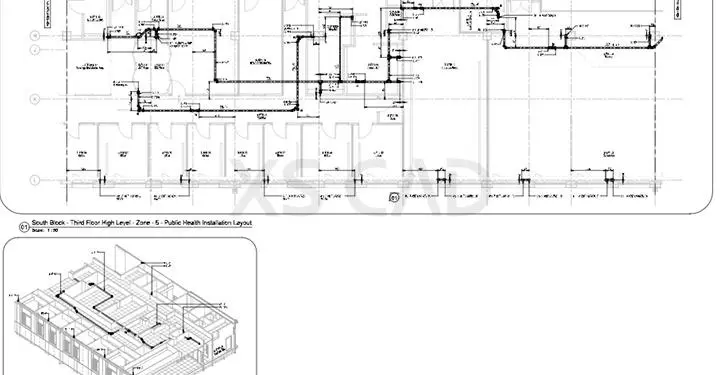Our Articles

How Advanced Is Hydraulic Design in Australia?
Learning about water, sewerage and hydraulic system design may not be every child’s dream and ideal in Australia, but in the past few decades, hydraulic engineering in buildings and hydraulic design services have seen significant evolution. New concepts and buzzwords have come with their own set of challenges, such as environmentally sustainable engineering, grey water recycling and blue roof storage attenuation. With experienced and expert design support, including accurate hydraulic design drawings, these new concepts can be put to good use.
Wastewater Recycling
In a country where dry weather can be the norm, wastewater recycling poses a number of benefits, such as:
As the population increases due to the steady influx of immigrants, there is an increase in water demand. Recycled wastewater can be an important source of water that can possibly help fill the gap when fresh water is lacking. Sources for urban reuse include sewage, grey water and rain water, where grey water refers to domestic waste water, excluding toilet flush. Recycled grey water is a large source, with a low organic content. Grey water can support quantity of water needed for toilet flushing, car washing and gardening.
Technologies used for grey water recycling included coarse filtration or membranes with disinfection. Later, biological-based technologies, such as rotating biological contactor, biological aerated filters and aerated bio-reactors were more carefully considered.
Blue roof storage attenuation is a solution of drainage by creating an elevated structural attenuation system, which functions separately from the flat roof drainage system. The attenuation system slowly drains water from the roof in normal use. For emergencies, the attenuation system can be skipped and the flat roof can be drained quickly.
A structural drainage void is created between the top of the roof waterproofing and the bottom of the attenuation lining membrane. As the blue roof tank sits inside the roof area, an overflow is created at the edge of the tank and above the roof outlets, facilitating a free-flow of rain water if the blue roof tank is full to capacity. Blue roof flow restrictors control the flow as required and integrate with roofing outlets. This system can be used for a range of roof finishes, such as soft landscaping to high-trafficked areas, and with several roof types, such as inverted roofs and podium decks.
Hydraulic Engineering Design
Hydraulic engineering for buildings has widened its range of services to include the design of the following:
It’s a formidable list, and as nobody wants a to deal with a faulty plumbing system, each and every part of hydraulic engineering design in construction must bear close scrutiny.
Firstly, building codes and standards may have to adapt to advances in technology and changes in types of buildings under construction. As more high-rises come up, the fluctuation of air pressures and resulting cross-contamination of high-rise drainage stacks may become an issue.
The AS3500 standard used to estimate pipe design flows to determine necessary pipe size and upon which water utilities base estimates for water demand may need to be revised. It was introduced in 1979 and revised in 2003. It does not account for half flush toilets and efficient fixtures and fittings and may contain an overstatement of requirements. Current Australian standards must also be revised regarding the installation of rainwater harvesting systems and tanks. Such kinds of standards must be revised to cater to the needs of modern buildings and building systems.
Research
Australia will also be impacted by research on plumbing and drainage overseas. In the United Kingdom, researchers have studied pressure surge analysis in large scale engineering fluid flow systems and have developed a modelling and simulation tool. A recent development includes a PAPA (positive air pressure attenuation) fixture which allows sealed systems to outperform naturally aspirated drainage stacks. Japan, Hong Kong and Taipei are refining plumbing systems, while Brazilian research on real time water usage data could well reshape water loading units globally.
Maintenance and the avoidance of contamination in pipework is another important part of hydraulic system overhaul. An Australia study found that lead levels in water pipes for 26 towns in Tasmania exceed national guidelines. In the future, greater consideration will be needed as to how pipes are going to be maintained and cleaned and how biofilm will be handled.
The water supply system in hydraulic systems will deteriorate and not only leak but have an excess of biofilm material built up over the years. Design and installation must be followed by long-term maintenance. Pipes must be cleaned as thoroughly and regularly as HVAC ducts.
As water engineering and sewerage learning lacks a certain appeal, there is a shortage of skilled professionals in this area, and those that are currently part of that skilled workforce are aging.
Pipe design, developed by those with a plumbing background, exhibits hands-on experience, but there is a dearth of skilled professionals who can provide hydraulic system design and hydraulic design services, such as hydraulic design drawings and residential hydraulic design layout, to include improved pipe works services.
There is considerable demand for hydraulic and public health engineering graduates and a sea of opportunities in Australia for those willing to pursue such careers. Hydraulic engineering is constantly evolving. Interesting opportunities may open up for those who stay interested.
XS CAD has valuable experience in providing hydraulic system design and hydraulic design services for building engineering firms. Our range of services for consultants and contractors across the world include hydraulic design drawings services. We create these models and drawings using Revit, AutoCAD and BIM Collaborate Pro for cloud collaboration.

